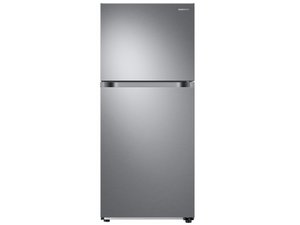Cause 1
The Evaporator Coils are Frosted Over
The defrost heater assembly turns on a few times throughout the day to melt away any frost that may have accumulated on the evaporator coils. If the defrost heater assembly is defective, frost will continue to accumulate on the evaporator coils, and the coils will become plugged with frost. If the evaporator coils are frosted over, the airflow through the coils will be restricted, causing the refrigerator not to cool. Check the evaporator coils to determine if they are frosted over. If the evaporator coils are frosted over, test each component of the defrost system.
Cause 2
Evaporator Fan Motor
The evaporator fan motor draws cold air over the evaporator coils and circulates it throughout the freezer. If the evaporator fan is not working, the freezer or refrigerator will not cool adequately. To determine if the evaporator fan motor is defective, try turning the fan blade by hand. If the fan blade does not turn freely, replace the fan motor. Additionally, if the motor is unusually noisy, replace it. Finally, if the motor does not run at all, use a multimeter to test the motor windings for continuity. If the windings do not have continuity, replace the evaporator fan motor..
Cause 3
Damper Control Assembly
The air damper control opens and closes to let the proper amount of cold air into the refrigerator compartment. If the damper does not open properly, it won’t let enough cold air into the refrigerator. Check the damper control to determine if it is broken or stuck closed.
Cause 4
Thermistor
The thermistor monitors the refrigerator temperature and sends the temperature reading to the control board. The control board then regulates power to the compressor and evaporator fan based on the thermistor readings. If the thermistor is defective, the compressor and evaporator fan may not run when necessary, or may run too frequently. To determine if the thermistor is defective, test it with a multimeter. The thermistor resistance should change in conjunction with the refrigerator temperature. If the thermistor resistance does not change, or the thermistor does not have continuity, replace the thermistor.
Cause 5
Temperature Control Board
The temperature control board provides voltage to the compressor and fan motors. If the control board is faulty, it may stop sending voltage to the compressor or fan motors. Control boards are often misdiagnosed—before replacing the control board, first test all of the more commonly defective components. If none of the other components are defective, consider replacing the temperature control board.
Cause 6
Defrost Control Board
The defrost control board determines how often to run the defrost cycle. If the defrost control board fails, the refrigerator will not run the defrost cycle, and frost will continue to accumulate on the evaporator coils. If the evaporator coils are frosted over, the refrigerator will work harder to remove heat. As a result, the refrigerator may be too warm. If the defrost thermostat and defrost heater are working properly, the defrost control board is likely defective and will need to be replaced.
Cause 7
Defrost Timer
The defrost timer turns on the defrost heater several times throughout the day to melt any frost that may have accumulated on the evaporator coils. If the defrost timer is defective, it might not advance into the defrost cycle, or it might not send power to the defrost heater during the defrost cycle. If the defrost system isn’t working, frost will continue to accumulate on the evaporator coils, and the refrigerator will have to work harder to remove heat. As a result, the refrigerator may be too warm. To determine if the defrost timer is defective, slowly advance the dial into the defrost cycle. The compressor should turn off and the heater should turn on. If the timer does not send power to the defrost components or advance out of the defrost cycle within 30 minutes, this indicates that the defrost timer is not advancing. If the defrost timer is not advancing, replace it.
Cause 8
Defrost Thermostat
The defrost thermostat monitors the temperature of the evaporator coils. When the coils drop below a set temperature, the thermostat contacts close to allow power to flow to the defrost heater during the defrost cycle. In the defrost cycle, the defrost heater melts any frost that may have accumulated on the evaporator coils. If the defrost thermostat is defective, the thermostat contacts will not close. As a result, the thermostat won’t provide power to the defrost heater. To determine if the defrost thermostat is defective, use a multimeter to test it for continuity. If the defrost thermostat does not have continuity when it reaches the low temperature of its operating range, replace it.
Cause 9
Main Control Board
The main control board might be defective. However, the control board is very rarely the cause of the problem. Before replacing the control board, first test all of the more commonly defective components. If none of these components are defective, consider replacing the main control board.
War diese Antwort hilfreich?
Bewertet
Rückgängig machen
Bewertung
3
Abbrechen
Schau durch den Thread, bis du den richtigen Platz für diesen Kommentar gefunden hast. Klicke dann auf "Den Kommentar diesem Post zuordnen", um ihn zu verschieben.

 1
1  1
1 
 2,6 Tsd.
2,6 Tsd.
1 Kommentar
spin your fan that was my problem
von melody altamirano